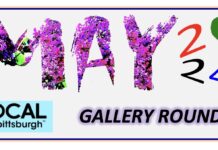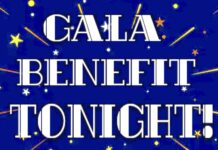By Emma Vescio
As a freshman in college, my extravagant, cowboy hat-wearing professor would casually drop clues about his life beyond the classroom. He was a ghostwriter in Paris, he traveled through America’s south redesigning homes, but most importantly to me, he spent years studying Hieronymus Bosch’s triptych The Garden of Earthly Delights. From 1503 to 1515, Bosch painted this masterpiece that would forever be cemented in art history. The work is horrifyingly beautiful in its depictions of indulgence and ecstasy; one could spend a lifetime examining the symbolism and meaning embedded in the intricate imagery.
Aimlessly scrolling through Instagram, I came across a profile for Garden of Artificial Delights. My interest piqued, I clicked through. This username represents the work of artist Soren Lundi, a queer artist living in Pittsburgh, PA. Much like the effect of Bosch’s Earthly Delights, Lundi’s work in embroidery and paper flowers uses a plethora of mediums to bring pleasure, wonder, and–without a doubt–delight to any viewer. I was quickly enamoured with his snakes constructed from sequins or insects with individualistic beading.
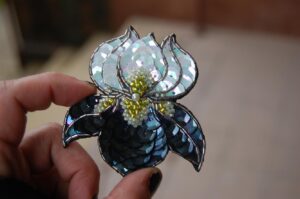 Originally from Pontiac, Michigan, about 40 minutes out of Detroit, Lundi began his journey as a self-taught artist. While he did take many classes as a child, he did not attend an art school because he was interested in multiple mediums and did not want to be narrowed down to one practice.
Originally from Pontiac, Michigan, about 40 minutes out of Detroit, Lundi began his journey as a self-taught artist. While he did take many classes as a child, he did not attend an art school because he was interested in multiple mediums and did not want to be narrowed down to one practice.
Working at the intersection of art and craft, Lundi’s artworks demand time and effort. Smaller works take between four and ten hours to create, while larger works take about 30 hours. Each bead is carefully placed to create images of snakes, swans, insects, and flowers. Lundi’s bouquets of paper flowers could easily be mistaken for the real deal much like an artificial delight allows us experience.
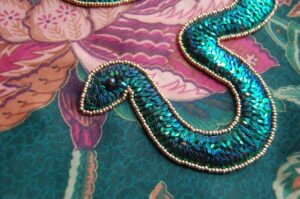 There are parallels to trends in fashion. Lundi’s beading work mimics the works of the late fashion designer Alexander McQueen circa Spring 1999, and creature themes are seen throughout Gucci’s latest shows that feature decadent and over-the-top, clashing patterns. Lundi is directly influenced by Art Nouveau, historical costuming, and a recent Metropolitan Museum of Art exhibit of ornately-decorated skeletons of saints. In terms of paper flowers, Lundi is greatly indebted to the work of Tiffanie Turner and her book The Fine Art of Paper Flowers, which provides instruction for constructing intricate paper flowers.
There are parallels to trends in fashion. Lundi’s beading work mimics the works of the late fashion designer Alexander McQueen circa Spring 1999, and creature themes are seen throughout Gucci’s latest shows that feature decadent and over-the-top, clashing patterns. Lundi is directly influenced by Art Nouveau, historical costuming, and a recent Metropolitan Museum of Art exhibit of ornately-decorated skeletons of saints. In terms of paper flowers, Lundi is greatly indebted to the work of Tiffanie Turner and her book The Fine Art of Paper Flowers, which provides instruction for constructing intricate paper flowers.
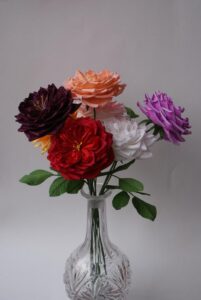 Artificiality and trompe l’oeil is at the forefront of Lundi’s pieces and is a theme of many queer artists’ works; both with physical objects and day-to-day life. The art of passing, the art of blending in, and the art of being accepted are acts that queer persons are masters of. The majority of Lundi’s work mirrors the lives of queer extravagance, and how so many individuals are able to make something out of nothing. The beauty of being tricked by an artificial flower is equivalent to the beauty of thinking a thrift store coat is a designer brand. The lurid and unexpected colors in Lundi’s flowers are in direct conversation with themes of camp. There is a deep amount of attention and appreciation to nature throughout Lundi’s work that allows the queerness of a paper flower to shine and the queerness of a beaded snake to live. Extravagance is not easy to replicate, and there is no way to have an authentic camp work without an understanding of abundance and hundreds of sequins.
Artificiality and trompe l’oeil is at the forefront of Lundi’s pieces and is a theme of many queer artists’ works; both with physical objects and day-to-day life. The art of passing, the art of blending in, and the art of being accepted are acts that queer persons are masters of. The majority of Lundi’s work mirrors the lives of queer extravagance, and how so many individuals are able to make something out of nothing. The beauty of being tricked by an artificial flower is equivalent to the beauty of thinking a thrift store coat is a designer brand. The lurid and unexpected colors in Lundi’s flowers are in direct conversation with themes of camp. There is a deep amount of attention and appreciation to nature throughout Lundi’s work that allows the queerness of a paper flower to shine and the queerness of a beaded snake to live. Extravagance is not easy to replicate, and there is no way to have an authentic camp work without an understanding of abundance and hundreds of sequins.
One of my favorite works by Lundi is a beaded swan pierced by an arrow. It reminds me of the magic that is seen throughout the work of Swedish painter Hilma af Klint especially the 24 paintings that constitute her The Swan paintings, recently shown at the Guggenheim. The mystique and wonder that are ignited with these works are also seen throughout Lundi’s paintings. He is currently working on a series of male nudes from Edwardian photo references.
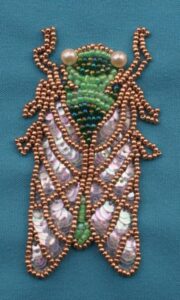 In 2020, Lundi’s work will be in multiple art exhibitions, starting with a hankie that will be shown in The Queer Ecology Hankie Project which will be premiering at the Irma Freeman Center in February. He also sells work at Small Mall in the Lawrenceville neighborhood or online at Etsy.
In 2020, Lundi’s work will be in multiple art exhibitions, starting with a hankie that will be shown in The Queer Ecology Hankie Project which will be premiering at the Irma Freeman Center in February. He also sells work at Small Mall in the Lawrenceville neighborhood or online at Etsy.







